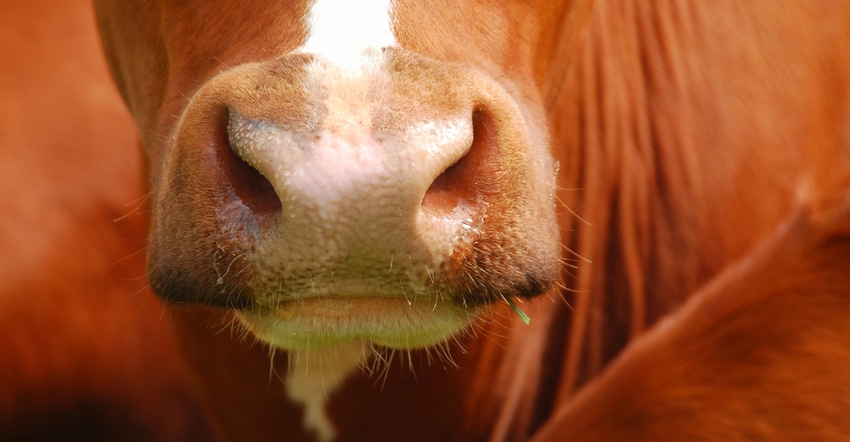August 9, 2019

An outbreak of vesicular stomatitis is spreading north. The latest cases are in western Colorado. Most cases involve horses, but in Colorado one case has been confirmed in cattle.
Russ Daly, South Dakota State University Extension veterinarian and the South Dakota’s State health veterinarian, recently answered questions about VS.
What does VS do to animals?
The main feature of VS in affected animals is the formation of blisters (vesicles) inside the mouth, on the tongue, the area where the mouth meets the lips, and sometimes on the teats of adult females. Blisters can also appear at the junction of the hooves and skin (coronary band), causing lameness.
However, by the time affected animals show signs of a problem and are examined, the blisters have almost always ruptured, leaving behind raw sores (erosions and ulcers) in the mouth (“stomatitis”), on the tongue, and other affected parts of the body. These sores make eating and drinking temporarily very painful and difficult.
Within a given infected herd, VS usually only affects a relatively small percentage of animals (10% to 20%).
What animals can get VS?
VS is most commonly noticed in horses. Cattle and pigs can also be affected; it’s very rarely seen in sheep, goats and llamas.
How do animals catch VS?
This disease is caused by a virus that’s most commonly spread by insect bites. The virus can survive and multiply well within small midges and black flies, which are the most common carrier of the disease.
Once animals become affected with the illness, though, they become very important sources of the virus for others.
The virus is prevalent in the mouth and other affected parts of the body: animals can catch VS by direct contact with an infected animal, or by indirect contact with feed, water, tack, or other items that were contaminated by an infected animal.
Can people catch VS?
Interestingly, yes. In people, VS tends to cause an illness that tends to mimic influenza (headache, fever, muscle aches that resolve in a few days) rather than the blisters it causes in animals. It usually only affects those people in very close contact with the germ (i.e., people working very closely with affected animals).
Where and when does VS occur?
Outbreaks of VS don’t occur every year, but when they do, it’s usually in the western U.S. (Texas, New Mexico and Colorado), and during the summer months because of the role of insects in its spread. The disease is not common at all in South Dakota, although a large number of farms in western South Dakota were affected in 2015. That year, a particularly large VS outbreak affected eight states, of which South Dakota was on the northeastern edge.
Why is VS such as concern?
Any disease that causes blisters in the mouth of livestock is a red flag for the veterinarians who work to keep our animals safe from foreign animal diseases. Foot and mouth disease (FMD) is the most concerning of these — a disease so contagious it could devastate the U.S. livestock industry. Mouth blisters caused by VS can’t be visually distinguished from those caused by FMD, so state and federal vets take time to ensure it is actually VS and not something different — taking samples for confirmation once these signs are noted in an animal.
One big tipoff as to the diagnosis, however, is that horses are not affected by FMD. Still, state and federal vets work to quarantine VS-affected animals to limit the disease’s spread.
What’s the treatment?
Being caused by a virus, there’s no specific treatment available for VS. Good nursing care, including providing soft feeds, tending to sores and watching for secondary bacterial infections (with appropriate antibiotic use), may help recovery. Luckily, VS is a self-limiting disease that most animals recover fully from over the course of one to two weeks.
Is there a vaccine?
Unfortunately, no vaccine exists for VS. Managing animals, particularly horses, to minimize contact with biting flies may aid in prevention. This may include taking animals off pastures during times of peak insect activity, pasturing away from water sources, and appropriate use of insecticides.
How might VS affect me, even if not present in my area?
States may put restrictions on the movement of animals from areas that are currently undergoing VS outbreaks.
What should I do if I suspect VS?
Call your veterinarian. If VS is a suspicion, they’ll contact the state veterinarian’s office, who will follow up with you and your veterinarian. It’s in the best interest of you, your animals and your neighbors to determine whether VS might be present in your herd.
Source: SDSU, which is solely responsible for the information provided and is wholly owned by the source. Informa Business Media and all its subsidiaries are not responsible for any of the content contained in this information asset.
You May Also Like




